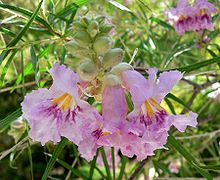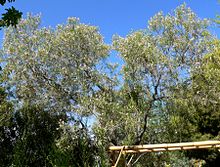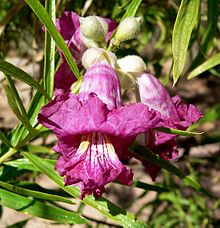- Chilopsis
-
Chilopsis linearis 
Flowers Scientific classification Kingdom: Plantae (unranked): Angiosperms (unranked): Eudicots (unranked): Asterids Order: Lamiales Family: Bignoniaceae Tribe: Tecomeae Genus: Chilopsis
D.Don[1]Species: C. linearis Binomial name Chilopsis linearis
(Cav.) SweetSynonyms Chilopsis is a genus of flowering plant, containing a single species, Chilopsis linearis. It is a small tree native to the southwestern United States and Mexico. The Hualapai people call it chimov and the Pima people call it aan. Despite the common name Desert-willow, given because of its willow-like leaves, it is actually a member of the bignonia family, Bignoniaceae. It is commonly seen in washes and along riverbanks at elevations below 1500 m in its range.
Ranging from 1.5 to as much as 8 meters in height, it can have the general appearance of either a shrub or a small tree. The linear curved leaves, ranging from 10–26 cm in length and 2–4 mm broad, are deciduous.
The generic name is derived from the Greek words χεῖλος, (cheilos), meaning "lip," and ὄψις (opsis), meaning "resembling," referring to the flowers. They occur in a terminal panicle or raceme; the bloom starts in May, and progresses into September, with 2-4 flowers open at any one time. The calyx is about 8–14 mm, slightly inflated, and varying shades of purple, while the corolla is 2–5 cm, and with colors ranging from lavender to light pink. The throat and lower lip has a pattern of yellow ridges and purple lines, and the margins are crinkled. It is pollinated primarily by large bees in the family Apidae, such as carpenter bees, bumblebees, Anthophora, and Centris. The fruit is a linear "pod" up to 35 cm long, containing numerous winged seeds.
There are two subspecies:
- Chilopsis linearis subsp. linearis. Utah, Arizona, New Mexico, western Texas, Mexico.
- Chilopsis linearis subsp. arcuata. Nevada, California, Baja California.
Cultivation and uses
It is cultivated for its large showy flowers, and tolerance of hot, dry climates. Although the natural growth is a very irregular shape, it can be readily pruned into a conventional tree shape. A number of cultivars have been selected, some (e.g. 'Rio Salado') with flowers of a dark and rich purple or magenta shades.
Chilopsis is closely related to the genus Catalpa and hybrids can be made between the two genera. The nothogeneric hybrid between Chilopsis linearis and Catalpa bignonioides has been named ×Chitalpa tashkentensis; as the name suggests, this hybrid was first raised in a botanic garden at Tashkent in Uzbekistan. It has broader leaves, up to 4 cm broad.
The leaves of Chilopsis linearis are traditionally used as an antifungal.[3]
The wood is reported to have been used for making bows and baskets.[4]
References
- ^ Quattrocchi, Umberto (2000). CRC World Dictionary of Plant Names. 1 A-C. CRC Press. p. 514. ISBN 9780849326752. http://books.google.com/books?id=esMPU5DHEGgC&.
- ^ "Chilopsis linearis (Cav.) Sweet". Germplasm Resources Information Network. United States Department of Agriculture. 2001-03-08. http://www.ars-grin.gov/cgi-bin/npgs/html/taxon.pl?10201. Retrieved 2010-01-27.
- ^ Moore, Michael (1989). Medicinal Plants of the Desert and Canyon West. Museum of New Mexico Press. ISBN 0-89013-104-X.
- ^ Vines, Robert (1960). Trees, Shrubs, and Woody Vines of the Southwest. University of Texas Press. ISBN 9780292734142.
External links
Categories:- Bignoniaceae
- Eudicot genera
- North American desert flora
- Trees of Northern Mexico
- Trees of the Southwestern United States
- Trees of Arizona
- Trees of California
- Trees of New Mexico
- Trees of Oklahoma
- Trees of Texas
- Flora of the California desert regions
- Flora of the U.S. Rio Grande Valleys
- Garden plants of North America
- Drought-tolerant trees
- Ornamental trees
- Plants and pollinators
- Monotypic plant genera
Wikimedia Foundation. 2010.


